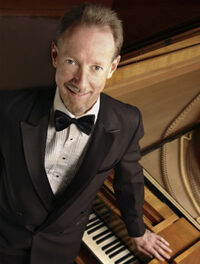For 25 years, the St. Lawrence String Quartet has enriched the cultural lives of music lovers around the world. The ensemble has set new standards of excellence, earning enthusiastic praise for its performances almost everywhere. Its members’ relaxed approach to the ever-increasingly important components of this once oh-so-refined business – that is to say, stage presence, rapport with audiences, and educational outreach* – are in keeping with the work of many other top groups. That maybe the SLSQ does these things even better may be one reason its leader, violinist Geoff Nuttall, was selected to replace Mr. Chamber Music, Charles Wadsworth, as host of the long-running series at Spoleto USA. He does most of the talking for the quartet, but that doesn’t mean his colleagues – violinist Mark Fewer, the ensemble’s newest member, violist Lesley Robertson, and cellist Christopher Costanza – don’t consistently operate at comparably high technical and artistic levels. All of the above was on display in Baldwin Auditorium as Duke Performances and the Chamber Arts Society brought the SLSQ back to Durham for yet another powerful evening of inspired and inspiring music-making.
The concert began late and was further delayed by a totally unnecessary introduction, larded with irrelevant comments about the pending announcement of a football trophy and a purportedly bilingual audience-participation game about turning off cell phones. Start on time, next time. This audience knows what it’s there for and how to behave.
There was no nonsense when the quartet came on stage and was seated, launching into Haydn’s “Joke” Quartet (No. 30, in E, H.III:38) before the last vestiges of welcoming applause had completely died away. This was Haydn to write home about, incisively and energetically played, with all those great SLSQ hallmarks, hallmarks of course of the very finest quartet playing imaginable. There was no powder on any wig, either, as these modern instrumentalists brought this old music to vibrant life. Mannheim was famous for its rockets but Esterhazy had its share of Roman candles, and the realization of this Haydn quartet by this visiting quartet demonstrated a fair share of them. There was wit and humor, too, and the keenly-engaged audience (how could it not have been?) seemed to get most of the jokes in the “Joke,” eliciting an expression of delight from Nuttall when the work ended. We’ve heard lots of Haydn hereabouts. This performance ranked with the very finest to date.
There followed the last of three quartets by Erich Wolfgang Korngold, dating from 1945 – his first concert piece since the start of WWII, during which he worked mostly in Hollywood as a film composer. This extraordinary score, richly laden with themes from some of Korngold’s best movies (because, ’tis said, he didn’t think those cinema efforts would last), proved to be the evening’s major discovery and major performance, too, on multiple levels. (The Doric has recorded all three of these quartets; a CD from the SLSQ would be a welcome addition to the catalog.)
The reasons this music captivated its hearers on this occasion must relate to the composer’s deft sense of time and place, echoing Schoenberg’s “Transfigured Night” as the war drew to a close, the outcome of which was increasingly certain to Korngold, although the magnitude of the world’s loss was gradually dawning, too. The music is thus bittersweet but ultimately positive and optimistic, if perhaps more spiritually so than of a celebratory nature. (The outstanding program note, by Susan Halpern, is worth keeping for possible future reference.) The performance itself seemed to glow from within, so much light and shade was brought to the four component voices, the perception of which, in the quite marvelous hall, was clean and precise, even from the very last row of the ground floor. Movie fans who cherish Korngold’s great scores – including Between Two Worlds, The Sea Wolf, and Deception (for one of whose themes this quartet was raided) – were surely in some semblance of seventh heaven, no pun intended. (And indeed the slow movement – the third – was so serene it elicited scattered applause all by itself.)
The finale was Bartók’s String Quartet No. 4, composed 17 years before the Korngold but still sounding much, much more modern. The composer’s six works in this form have been played here often, and with every hearing, they seem more penetrating. The SLSQ’s experience and insight brought this score to new levels of technical polish, to be sure, accompanied by some of the most moving playing yet enjoyed here. The third movement, in particular, plumbed emotional depths like few other readings in memory. There was a considerable uproar at its conclusion. The crowd clearly approved.
And after a short while, there was a palette cleanser, in the form of the slow movement (Affetuoso e sostenuto) of Haydn’s Op. 20, No. 1 (H.3:31). As Nuttall put it, “A little something to take the edge off.” It did that, and more.
There were too many empty seats for a program of this exalted caliber. Yes, there’s a lot going on, but I am astonished this was not SRO.
*For an example of the SLSQ’s superior educational efforts (and with a mostly adult audience), see this recent review, from Asheville.
Footnote that really is a footnote: Fans of haut couture should know that Nuttall had on black Wellingtons with (apparently) black socks, thus displaying none of his customary flashes of color in footwear.











